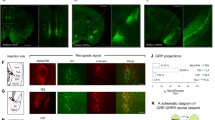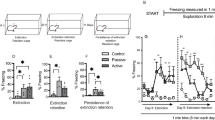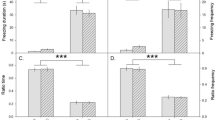Abstract
Individuals respond differently to traumatic experiences, including their propensity to develop posttraumatic stress disorder (PTSD). Understanding individual differences in PTSD vulnerability will allow the development of improved prevention and treatment options. Here we characterized fear conditioning and extinction in rats selectively bred for differences in their locomotor response to a novel environment. Selectively bred high-responder (bHR) and low-responder (bLR) male rats are known to differ in their emotional reactivity on a range of measures of spontaneous anxiety- and depressive-like behaviors. We demonstrate that bHRs have facilitated extinction learning and retention compared with outbred Sprague Dawley rats, whereas bLRs show reduced extinction learning and retention. This indicates that bLRs are more vulnerable to PTSD-like behavior. Fibroblast growth factor 2 (FGF2) has previously been implicated in the development of these behavioral phenotypes and facilitates extinction learning in outbred animals, therefore we examined the effects of early-life FGF2 on bHR and bLR behavior. FGF2 administered on the day after birth facilitated extinction learning and retention in bHRs, but not in bLRs or control rats, during adulthood. This indicates that, under the current fear conditioning paradigm, early-life FGF2 has protective effects only in resilient animals. This stands in contrast to FGF2’s ability to protect vulnerable animals in milder tests of anxiety. These results provide a unique animal model of individual differences in PTSD-like behavior, allowing the study of genetic, developmental, and environmental factors in its expression.
Similar content being viewed by others
Log in or create a free account to read this content
Gain free access to this article, as well as selected content from this journal and more on nature.com
or
References
Aurbach EL, Inui EG, Turner CA, Hagenauer MH, Prater KE, Li JZ et al (2015). Fibroblast growth factor 9 is a novel modulator of negative affect. Proc Natl Acad Sci USA 112: 11953–11958.
Blanchard DC, Hynd AL, Minke KA, Minemoto T, Blanchard RJ (2001). Human defensive behaviors to threat scenarios show parallels to fear- and anxiety-related defense patterns of non-human mammals. Neurosci Biobehav Rev 25: 761–770.
Blechert J, Michael T, Vriends N, Margraf J, Wilhelm FH (2007). Fear conditioning in posttraumatic stress disorder: evidence for delayed extinction of autonomic, experiential, and behavioural responses. Behav Res Ther 45: 2019–2033.
Bomyea J, Risbrough V, Lang AJ (2012). A consideration of select pre-trauma factors as key vulnerabilities in PTSD. Clin Psychol Rev 32: 630–641.
Chaudhury S, Aurbach EL, Sharma V, Blandino P Jr., Turner CA, Watson SJ et al (2014). FGF2 is a target and a trigger of epigenetic mechanisms associated with differences in emotionality: partnership with H3K9me3. Proc Natl Acad Sci USA 111: 11834–11839.
Contractor AA, Armour C, Shea MT, Mota N, Pietrzak RH (2015). Latent profiles of DSM-5 PTSD symptoms and the ‘Big Five’ personality traits. J Anxiety Disord 37: 10–20.
Difede J, Cukor J, Wyka K, Olden M, Hoffman H, Lee FS et al (2014). D-cycloserine augmentation of exposure therapy for post-traumatic stress disorder: a pilot randomized clinical trial. Neuropsychopharmacology 39: 1052–1058.
Duclot F, Perez-Taboada I, Wright KN, Kabbaj M (2016). Prediction of individual differences in fear response by novelty seeking, and disruption of contextual fear memory reconsolidation by ketamine. Neuropharmacology 109: 293–305.
Fitzgerald PJ, Seemann JR, Maren S (2014). Can fear extinction be enhanced? A review of pharmacological and behavioral findings. Brain Res Bull 105: 46–60.
Flagel SB, Waselus M, Clinton SM, Watson SJ, Akil H (2014). Antecedents and consequences of drug abuse in rats selectively bred for high and low response to novelty. Neuropharmacology 76(Pt B): 425–436.
Graham BM, Richardson R (2009). Acute systemic fibroblast growth factor-2 enhances long-term extinction of fear and reduces reinstatement in rats. Neuropsychopharmacology 34: 1875–1882.
Graham BM, Richardson R (2010). Fibroblast growth factor-2 enhances extinction and reduces renewal of conditioned fear. Neuropsychopharmacology 35: 1348–1355.
Graham BM, Richardson R (2011). Memory of fearful events: the role of fibroblast growth factor-2 in fear acquisition and extinction. Neuroscience 189: 156–169.
Graham BM, Richardson R (2015). Fibroblast growth factor 2 as a new approach to fighting fear. JAMA Psychiatry 72: 959–960.
Graham BM, Richardson R (2016). Individual differences in the expression of conditioned fear are associated with endogenous fibroblast growth factor 2. Learn Mem 23: 42–45.
Harrison LA, Ahn C, Adolphs R (2015). Exploring the structure of human defensive responses from judgments of threat scenarios. PLoS ONE 10: e0133682.
Holly EN, Miczek KA (2015). Capturing individual differences: challenges in animal models of posttraumatic stress disorder and drug abuse. Biol Psychiatry 78: 816–818.
Jaccard J, Becker MA (2009) Statistics for the Behavioral Sciences, 5th edn. Wadsworth/Thomson Learning: Belmont, CA, USA, 736 pp.
Kerman IA, Clinton SM, Bedrosian TA, Abraham AD, Rosenthal DT, Akil H et al (2011). High novelty-seeking predicts aggression and gene expression differences within defined serotonergic cell groups. Brain Res 1419: 34–45.
Kessler RC, Sonnega A, Bromet E, Hughes M, Nelson CB (1995). Posttraumatic stress disorder in the National Comorbidity Survey. Arch Gen Psychiatry 52: 1048–1060.
Khan AA, Jacobson KC, Gardner CO, Prescott CA, Kendler KS (2005). Personality and comorbidity of common psychiatric disorders. Br J Psychiatry 186: 190–196.
Lommen MJ, Engelhard IM, Sijbrandij M, van den Hout MA, Hermans D (2013). Pre-trauma individual differences in extinction learning predict posttraumatic stress. Behav Res Ther 51: 63–67.
Maren S, Phan KL, Liberzon I (2013). The contextual brain: implications for fear conditioning, extinction and psychopathology. Nat Rev Neurosci 14: 417–428.
Milad MR, Pitman RK, Ellis CB, Gold AL, Shin LM, Lasko NB et al (2009). Neurobiological basis of failure to recall extinction memory in posttraumatic stress disorder. Biol Psychiatry 66: 1075–1082.
Milad MR, Rosenbaum BL, Simon NM (2014). Neuroscience of fear extinction: implications for assessment and treatment of fear-based and anxiety related disorders. Behav Res Ther 62: 17–23.
Norrholm SD, Jovanovic T, Olin IW, Sands LA, Karapanou I, Bradley B et al (2011). Fear extinction in traumatized civilians with posttraumatic stress disorder: relation to symptom severity. Biol Psychiatry 69: 556–563.
Orr SP, Lasko NB, Macklin ML, Pineles SL, Chang Y, Pitman RK (2012). Predicting post-trauma stress symptoms from pre-trauma psychophysiologic reactivity, personality traits and measures of psychopathology. Biol Mood Anxiety Disord 2: 8.
Orr SP, Metzger LJ, Lasko NB, Macklin ML, Peri T, Pitman RK (2000). De novo conditioning in trauma-exposed individuals with and without posttraumatic stress disorder. J Abnorm Psychol 109: 290–298.
Perez JA, Clinton SM, Turner CA, Watson SJ, Akil H (2009). A new role for FGF2 as an endogenous inhibitor of anxiety. J Neurosci 29: 6379–6387.
Stead JD, Clinton S, Neal C, Schneider J, Jama A, Miller S et al (2006). Selective breeding for divergence in novelty-seeking traits: heritability and enrichment in spontaneous anxiety-related behaviors. Behav Genet 36: 697–712.
Turner CA, Clinton SM, Thompson RC, Watson SJ Jr., Akil H (2011). Fibroblast growth factor-2 (FGF2) augmentation early in life alters hippocampal development and rescues the anxiety phenotype in vulnerable animals. Proc Natl Acad Sci USA 108: 8021–8025.
Turner CA, Gula EL, Taylor LP, Watson SJ, Akil H (2008). Antidepressant-like effects of intracerebroventricular FGF2 in rats. Brain Res 1224: 63–68.
Acknowledgements
We thank Pamela Maras for assistance with early-life FGF2 injections. We also thank Angela Koelsch, Jim Stewart, and Fei Li for their assistance with the colony of selectively bred animals and technical assistance; Amy Tang and Jennifer Fitzpatrick for their technical assistance; and Jonathan Morrow, Tom Dixon, Jim Burton, Loren Rector, and Doug Smith for their assistance with the fear conditioning equipment and recording setup.
Author information
Authors and Affiliations
Corresponding author
Additional information
Supplementary Information accompanies the paper on the Neuropsychopharmacology website
Supplementary information
Rights and permissions
About this article
Cite this article
Prater, K., Aurbach, E., Larcinese, H. et al. Selectively Bred Rats Provide a Unique Model of Vulnerability to PTSD-Like Behavior and Respond Differentially to FGF2 Augmentation Early in Life. Neuropsychopharmacol 42, 1706–1714 (2017). https://doi.org/10.1038/npp.2017.37
Received:
Revised:
Accepted:
Published:
Issue date:
DOI: https://doi.org/10.1038/npp.2017.37



